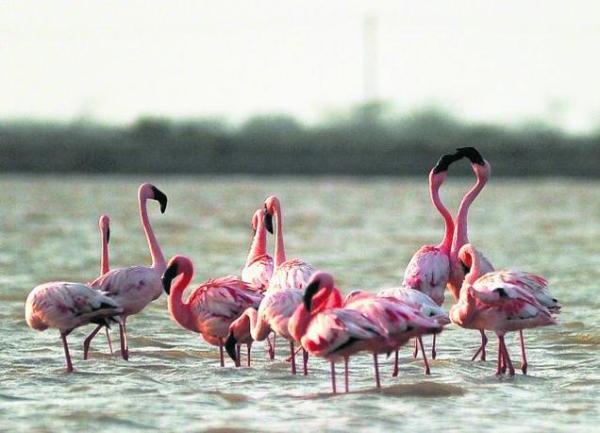This is the flamingo season. But, it looks the Pink Wall in the wetlands along the shores in Pulicat and Point Calimere, is thinning down.
Two decades ago, there were a million birds flying into Point Calimere, half-a-lakh of which were flamingos. Similarly, the bird census in Pulicat, a decade ago, used to reveal a count of over a lakh flamingos.
Last week, the Nature Trust volunteers spotted about 20,000 flamingos in Pulicat, on the Andhra Pradesh side of the lake. “It is meagre compared to the one lakh documented five years ago,” says K.V.R.K. Thirunaranan of Nature Trust. “What we saw are the Greater Flamingos. The Lesser Flamingos will be spotted later in the Tamil Nadu side of the lake,” he says.
“We could spot colonies of thousands. And there was a Pink Wall behind. The count could be more,” he says attributing the dwindling arrivals to developments being taken up around the lake bordering Tamil Nadu and Andhra Pradesh.
While climate change could be the main reason, the thriving real estate sector and over-fishing as even farmers take to fishing during the migratory season depriving the birds of their feed was affecting the eco-system, he says.
At Point Calimere, the heavy rains this season have heralded the arrival of the flamingos, the prima donnas of the sanctuary, this winter. According to forest officials, 15,000 to 20,000 flamingos have arrived at the Great Vedaranyam Swamp beginning last October.
Meanwhile, tourists and pilgrims who take a rough ride to Dhanushkodi on Tuesday to take a glimpse of the ruins were pleasantly surprised to see the flamingos flocking to the lagoon, presenting a great sight.
The decline in the number of birds visiting the sanctuary, especially in winter led to the opening of bird migratory study centre by the Bombay Natural History Society (BNHS) in association with the State Forest Department five years ago. Point Calimere is a crucial link in the migratory chain of the birds.
Meanwhile, the tourists and pilgrims who take a rough ride on the sandy terrain to Dhanushkodi to take a glimpse of the ruins are pleasantly surprised to see the flamingos flocking to the lagoon.
The long-legged pink-birds, which live in colonies, are congregating near Sri Kothandarama Temple, Arichalmunai and other spots in the lagoon. “Belonging to Greater Flamingos species, the birds migrated all the way from Iran and southern parts of Russia mainly for feeding in the shallow water,” said S. Balachandran, Deputy Director, BNHS.
The birds visit Dhanuskodi during December-March every year for feeding. “After ending the season in Dhanuskodi, they will fly to Sri Lanka and after a break, will fly back to their respective places for breeding,” Mr. Balachandran said.
Usually, birds arrive at the wetlands along the eastern shore of Tamil Nadu from the Arctic region during winter and store energy in the form of fat to fly back to their nesting sites. The shallow ponds in brackish waters, especially during northeast monsoons provide food, by way of small organisms. The industries along the coast have endangered the already fragile coastal ecology, ornithologists say.
A BIRD’S EYE VIEW
*The birds visit Dhanushkodi during December-March every year for feeding.
*Two decades ago, a millon birds were flying into Point Calimere, half-a-lakh of which were flamingos.
*Similarly, the bird census in Pulicat a decade ago used to reveal a count of over a lakh flamingos.
*According to forest officials, 15,000 to 20,000 flamingos arrived at the Great Vedaranyam Swamp beginning October last.






Leave a reply